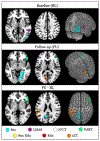Neural similarity across task load relates to cognitive reserve and brain maintenance measures on the Letter Sternberg task: a longitudinal study
- PMID: 36484923
- PMCID: PMC9925407
- DOI: 10.1007/s11682-022-00746-2
Neural similarity across task load relates to cognitive reserve and brain maintenance measures on the Letter Sternberg task: a longitudinal study
Abstract
The aging process is characterized by change across several measures that index cognitive status and brain integrity. In the present study, 54 cognitively-healthy younger and older adults, were analyzed, longitudinally, on a verbal working memory task to investigate the effect of brain maintenance (i.e., cortical thickness) and cognitive reserve (i.e., NART IQ as proxy) factors on a derived measure of neural efficiency. Participants were scanned using fMRI while presented with the Letter Sternberg task, a verbal working memory task consisting of encoding, maintenance and retrieval phases, where cognitive load is manipulated by varying the number of presented items (i.e., between one and six letters). Via correlation analysis, we looked at region-level and whole-brain relationships between load levels within each phase and then computed a global task measure, what we term phase specificity, to analyze how similar neural responses were across load levels within each phase compared to between each phase. We found that longitudinal change in phase specificity was positively related to longitudinal change in cortical thickness, at both the whole-brain and regional level. Additionally, baseline NART IQ was positively related to longitudinal change in phase specificity over time. Furthermore, we found a longitudinal effect of sex on change in phase specificity, such that females displayed higher phase specificity over time. Cross-sectional findings aligned with longitudinal findings, with the notable exception of behavioral performance being positively linked to phase specificity cross-sectionally at baseline. Taken together, our findings suggest that phase specificity positively relates to brain maintenance and reserve factors and should be better investigated as a measure of neural efficiency.
Keywords: Brain maintenance; Cognitive reserve; Longitudinal; Within-subjects fMRI; Working memory.
© 2022. The Author(s), under exclusive licence to Springer Science+Business Media, LLC, part of Springer Nature.
Conflict of interest statement
Conflict of interest
The authors confirm that they have no conflict of interest to declare.
Figures





References
-
- Altamura M, Elvevåg B, Blasi G, Bertolino A, Callicott JH, Weinberger DR, … & Goldberg TE (2007). Dissociating the effects of Sternberg working memory demands in prefrontal cortex. Psychiatry Research: Neuroimaging, 154(2), 103–114. - PubMed
-
- Andersson JL, Jenkinson M, & Smith S (2007). Non-linear registration, aka Spatial normalisation FMRIB technical report TR07JA2. FMRIB Analysis Group of the University of Oxford, 2(1), e21.
-
- Atkinson AL, Baddeley AD, & Allen RJ (2018). Remember some or remember all? Ageing and strategy effects in visual working memory. Quarterly Journal of Experimental Psychology, 71(7), 1561–1573. - PubMed
-
- Baddeley A (1992). Working memory. Science, 255(5044), 556–559. - PubMed
-
- Baddeley A (2012). Working memory: theories, models, and controversies. Annual Review of Psychology, 63, 1–29. - PubMed
MeSH terms
Grants and funding
LinkOut - more resources
Full Text Sources

